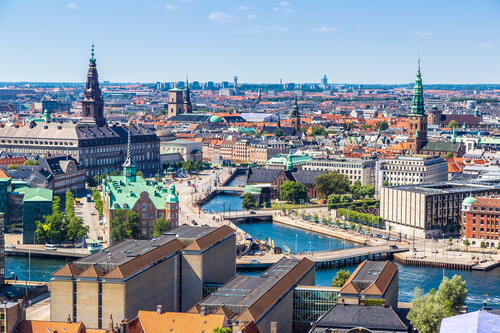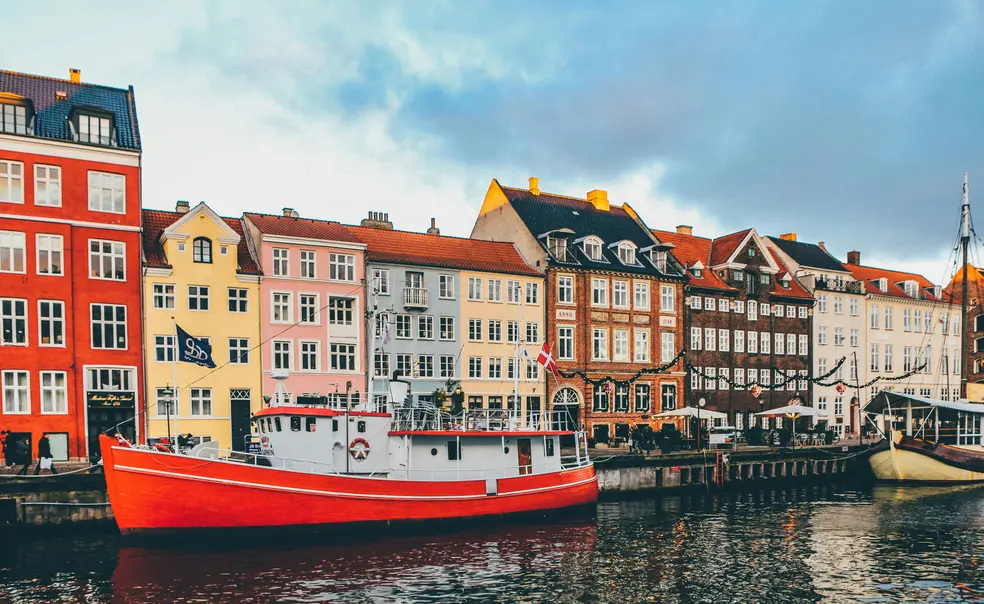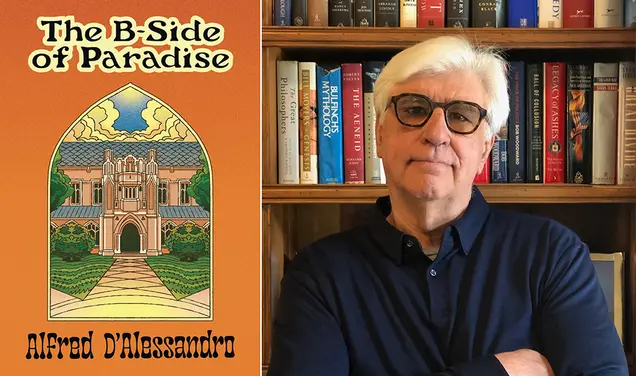Jake Caddeau ’20 Reflects on the Simple Pleasures of Copenhagen
First things first. Find a hot dog stand and eat a hot dog. In my youth, this was an activity mainly reserved for Yankee, Trenton Thunder, and Princeton basketball games or the Fourth of July. As it turns out, it is also a staple of Danish culture.
When you arrive in Copenhagen, you’ll see that the city is brimming with them. Every neighborhood, every corner, every square has its own vendor, and many Danes are opinionated about what should go on one. Fried onions, remoulade, and pickled cucumbers are some of the staples.

The time to go is from June to early September, when the city gets more than 17 hours of daylight each day and temperatures are in the mid-60s and 70s. On sunny days, hundreds of people lay out on towels on the wooden boardwalks along the edge of the harbor, soaking up the Northern sun and at periodic intervals, diving into the crisp water to cool off.
In the city, choosing a neighborhood to stay in will depend on what type of experience you’re looking for. Indre By is the most central — closer to tourist attractions, shopping, old churches, and museums. Walking through its maze of cobblestone streets you feel the history familiar to old European city centers. Frederiksberg, which is northwest of the center, on the other side of the Søern — a row of three rectangular lakes which were dammed in the middle ages and fortified in the 1500s to protect the city from invaders — is where to stay if you want to see where the Danes live. It’s more family oriented, with quiet streets of tall, washed-out colored apartment buildings with a distinctly Scandinavian feel. The city is small enough that nothing is hard to get to. From Frederiksberg, the city center is a short 15-20-minute walk, but the preferred method of transport is biking. Just be careful around the commuting hours when the bike lanes become crowded with commuters heading to all lines of work — a sight to behold.
The city’s coolest neighborhood though is Refshaleøen, a former industrial area that is now home to design studios, cafes, and a beautiful segment of coastline along the harbor. On my first day in the city, I biked to Refshaleøen with a childhood friend and his fiancée, who live in Copenhagen, to watch the annual Dødsing, or “Death Diving,” competition. Competitors had traveled from all over Scandinavia to effectively belly flop from a 40-foot-high dive while a panel of judges rated them on the size of their splashes.
Where to eat:
Another must visit in Refshaleøen is La Banchina, a restaurant and wine bar with its own dock on the edge of the harbor. Order fresh fish and other seafood at the window, and you’ll be given a buzzer to take with you down to the dock where patrons lay out in swimsuits eating their food and cooling off in the water. If you’re able to, it is worth it to reserve a two-hour session in the private sauna with a view of the dock. It’s a beautiful space and an unmatched way to spend an afternoon relaxing.

Other restaurants to visit include Aamanns 1921, which is located in the city center and serves traditional Danish smørrebrød — open faced sandwiches of rye bread with toppings such as pickled herring, mackerel and salmon — and Nr.30, a wine bar a couple blocks off the lakes which serves a turbot in a thick creamy sauce with dill that conjured a feeling as warm as the memory of my grandmother kissing my cheek. At Amator, a breakfast cafe, you’ll find a delightfully soft omelet and chic atmosphere. Poulette, in Frederiksberg has become known across the wide world of Tiktok as Dua Lipa’s favorite fried chicken sandwich. It is also mine, but I’ve received much less publicity. Kødbyens Fiskebar serves a lobster donut topped with caviar that would be criminal to skip. Finally, it’s important not to forget the city’s many bakeries. Two must-visits are Juno and Hart. One of the baked-good specialties is a bun-butter-cheese, which is exactly what it sounds like: a buttered bun with cheese inside. Delicious and very Danish.
Where to go:
For a day trip, take the train an hour north to the Louisiana Museum, a stunning estate on the coast of Humlebaek with collections from Scandinavia and around the world. The space is a beautiful mix of modern and traditional architecture and stunning views of Sweden across the sea.
For those wishing for an even slower paced getaway, Bornholm, a picturesque island in the Baltic Sea is the place to go. It’s an hour flight from Copenhagen, or you can take a train and a ferry. It’s lush with sweeping views of farms, rolling green hills, and forests. If you go, make sure to visit Dueodde, an impossibly gorgeous white sand beach. The island feels like the Nantucket of Denmark — a quiet escape with a creative soul where time seems to move with the tide. The best restaurant in the island is Kadeau (no relation to the author), which offers a seasonal tasting menu sourced almost entirely from the island itself.
Denmark has a way of disarming you. It’s not flashy or fast-paced. Instead, it draws you in with its quiet confidence, the kind that comes from good design, good food, and a deep-rooted sense of balance. Life here feels intentional. From the bike lanes to the harbor saunas, the smørrebrød to the sea air, there’s a rhythm there that invites you to slow down, look around, and breathe a little deeper. It’s a country that rewards curiosity and celebrates simplicity. It’s a special type of place that can make hot dogs feel like luxury.












2 Responses
Peter Severson ’09
1 Month AgoMore Treasures to Visit in Denmark and Sweden
I have family in Denmark and have been over to visit a number of times in my life. I very much agree with the sentiment that it’s a slower-paced, less flashy place to visit, but richly rewarding for the right kind of traveler. For an even more comprehensive visit to Sjælland, one might consider the undersea train to Malmö, Sweden, just across the Øresund or heading north from Copenhagen to Helsingør & Hamlet’s castle, where actors perform vignettes from the play around the castle. There’s even more to see on the mainland in Jylland: Aarhus is a rewarding second city experience and features Den Gamle By for a window into older ways of life; the shifting sand dunes on the coasts up toward Skagen, the point where the seas meet, are stunning; Thy National Park is on the northwest coast; and down south you’ll find the Jelling Stones, a UNESCO World Heritage Site (and source of the rune for King Harald Bluetooth, which appears ubiquitously today as the bluetooth symbol on electronic devices).
James Swinehart ’27
1 Month AgoThe Essence of Copenhagen
Big fan of this article and La Banchina! I spent Fall Break in the city, and you’ve captured its essence beautifully.